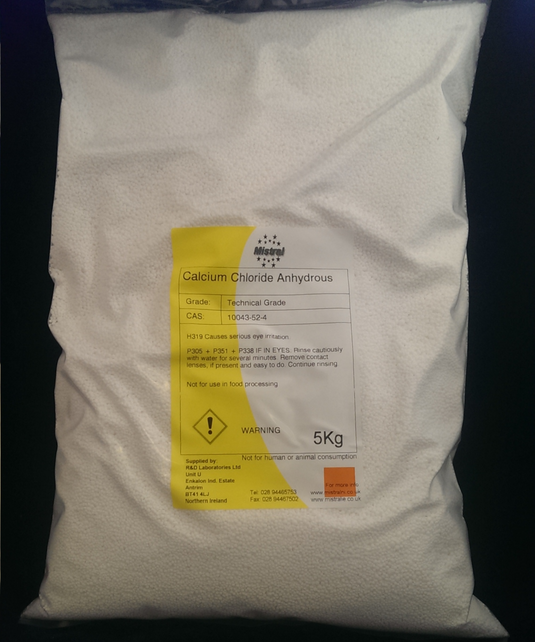Calcium Chloride Anhydrous
Technical grade Prills
Calcium chloride anhydrous is an odourless white solid in the form of small granules / pellets. It is deliquescent (absorbs moisture from the air) and rapidly dissolves in water producing heat (exothermic). It is commercially produced by the Solvay Process. It has many industrial applications and is commonly used to prevent dusting, as a drying agent and to melt ice. It is used in swimming pools and aquariums as a pH buffer and a rapid source of calcium ions.
Click here if you are looking for Calcium Chloride Dihydrate
Properties of calcium chloride anhydrous:
- Other names: Calcium(II) chloride , Calcium dichloride,
- CAS No: 10043-52-4
- EC No: 233-140-8
- UN No: non hazardous for transportation
- Purity: 94.5% minimum calcium chloride
- Appearance: white granules/pellets
- Molar Mass: 110.98g/mol
- Density: 2.15 g/cm3
- Melting Point: 772oC
- Boiling Point: 1935oC
- Solubility: 40% @20C
- pH: 8-9 (10% solution)
Calcium chloride is soluble in water, alcohols, acetic acid and acetone.
- Rapid dissolving solid.
- Fast release of calcium ions into solution.
- High grade with low levels of impurities.
- Versatile - has many applications.
Uses for calcium chloride
- A drying agent to remove moisture (desiccant).
- As a brine for refrigeration systems.
- An ice melting compound both in solid and liquid forms.
- An accelerant for concrete setting.
- In reef aquariums to add calcium for growth of coral, clams, algae etc.
- Increases water hardness in swimming pools helping to prevent erosion of concrete in pools. It also acts as a pH buffer.
- As an anti dusting agent for floors, roads etc.
- Added to fabric conditioner formulas to thin down the quaternary surfactants.
- It is used in self heating cans and heat pads due to its exothermic properties.
Directions for use will depend on intended application.
How to use in Aquariums & Reef tanks:
Increasing 1 dGH of Calcium (7.14691 ppm) in 1 litre of water using Calcium Chloride:
7.14691 / (40.078 / 147.01396) = 26.21626 mg/Litre
Therefore to raise the calcium levels by 10ppm in 100L of water you need to add 3.67g of calcium chloride.
Optimum level should be approx 380 - 450ppm (ideally 420ppm). It is not advisable to raise calcium levels by more than 20ppm per day.
Calcium chloride for ice melting
This is an efficient method for the removal of ice and snow from paths, drives and walkways. It works by reacting with moisture to create heat which instantly starts melting the ice. It reacts 8 times faster than conventional salt and operates at temperatures below -25C. As it penetrates the ice it fractures the structure of the ice which ultimately collapses when walked on or driven on.
It leaves no corrosive residue like salt which can damage carpets making it ideal for use around entrances of offices, nursing homes, factories, car parks, restaurants, schools etc. It also helps to stop ice forming on surfaces and can be used for preventative maintenance.
To use, simply sprinkle a handful per square metre of ice and let the product get on with it.
BENEFITS
- Fast acting - Goes to work immediately
- 8 times faster than salt.
- Melts ice and snow, prevents refreezing
- Effective to -25C.
- Economical to use.
- Non corrosive on air entrained concrete.
- Provides peace of mind, making walkways and paths safer for all.
Directions for use will depend on intended application.
Calcium chloride as a Dessicant / Drying Agent
Anhydrous Calcium Chloride will absorb over 200% of its own weight in moisture. It is non toxic and odourless. To use for absorbing moisture from the air simply place the calcium chloride pellets in a shallow dish and set in an open space in the room. Ideal for caravans, houses and holiday homes which are left empty over the winter and storage rooms For use in luggage and packages the pellets can be placed in a small mesh bag. Also an effective drying agent for use in the laboratory.
As the pellets absorb moisture they will eventually turn into a slush when no more water can be absorbed. At this stage simply refill containers and start again.
TREATMENT OF BITTER PIT & CORK SPOT
To use as foliar spray: Dilute 1kg of calcium chloride for every 420L of water. Apply by spraying over leaves every 2 weeks for 5 weeks up to two weeks before harvesting.
Health & safety
This substance does not meet the classification criteria of the EC Directives 67/548/EEC, 1999/45/EC or 1272/2008.
Click here to view Sales Specification Sheet
PLEASE NOTE: This product is not for human or animal consumption.
